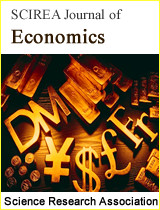The effect of unemployment on the economy of Ghana
DOI: 10.54647/economics79350 147 Downloads 15536 Views
Author(s)
Abstract
Purpose – Ghana has consistently been ranked among the ten fastest-growing African economies since 2017, but in 2020, falling oil prices and the COVID-19 pandemic plunged the country into economic recession. The objective of this study is to measure the heterogeneous effects of the COVID 19 crisis, through the prism of unemployment, populations, and the Ghanaian economy. This involves identifying which profiles of job seekers, and which territory profiles have been particularly vulnerable to the crisis.
Design/methodology/approach – The methodology followed in this study consists in carrying out linear regressions on data from the World Bank database to see which variables affect the unemployment rate.
Findings –The additional financial costs generated by unemployment and the fear of unemployment also contribute to increasing the state's public debt.
Research limitations/implications –. Any scientific work has its limits. Our research only focused on the effects of unemployment in Ghana; we could have looked at the case of other countries in the sub-region, namely ECOWAS.
Practical implications –. In Ghana, as in the rest of the world, youth unemployment seems to be a truly structural phenomenon, as the elasticity of youth employment concerning GDP growth is limited.
Social implications –. It is noted that a young person in a situation of unemployment and underemployment, constitutes a loss for himself and the society because he does not participate in the economic life of his environment or even his country.
Originality/value – The originality of this work concerns the consideration of the role played by the geographical location of job seekers, their competitors in the labor market, and vacant jobs on the probability for job seekers to exit unemployment.
Keywords
Covid19, economy, Unemployment, Human resources management, Ghana
Cite this paper
Andrews Yao Dumevi,
The effect of unemployment on the economy of Ghana
, SCIREA Journal of Economics.
Volume 8, Issue 1, February 2023 | PP. 1-20.
10.54647/economics79350
References
| [ 1 ] | Aghion, P. and Howitt, P. (1994), “Growth and Unemployment”, The Review of Economic Studies, Vol. 61 No. 3, pp. 477-494. https://doi.org/10.2307/2297900. |
| [ 2 ] | Asami, J.A., Amertil, N.P., Ismaila, H., Akugri, F.A. and Nabyonga-Orem, J. (2020), “The imperative of evidence-based health workforce planning and implementation: lessons from nurses and midwives unemployment crisis in Ghana”, Human Resources for Health, Vol. 18 No. 16. https://doi.org/10.1186/s12960-020-0462-5. |
| [ 3 ] | Blustein, D.L. (2019), The importance of work in an age of uncertainty: The eroding work experience in America, Oxford University Press, Oxford, UK. |
| [ 4 ] | Caporale, G.M. and Gil-Alana, L.A. (2018), “Unemployment in Africa: a fractional integration approach”, South African Journal of Economics, Vol. 86 No. 1, pp. 76-81. https://doi.org/10.1111/saje.12178. |
| [ 5 ] | Claveria, O. (2019), “Forecasting the unemployment rate using the degree of agreement in consumer unemployment expectations”, Journal for Labour Market Research, Vol. 53 No. 3. https://doi.org/10.1186/s12651-019-0253-4. |
| [ 6 ] | Holte, F.C. (2022), “Four Papers on the Theory of Unemployment”, available at: https://www.ssb.no/a/histstat/rapp/rapp_198711.pdf (accessed 11 April 2022) |
| [ 7 ] | International Labour Organization, ILOSTAT database (2022), “Unemployment, total (% of total labor force) (modeled ILO estimate)”, available at: https://data.worldbank.org/indicator/SL.UEM.TOTL.ZS (accessed 3 April 2022) |
| [ 8 ] | Karl, B. and Allan, M. (2022), “The Theory of Employment and Unemployment”, available at: https://doi.org/10.1184/R1/6708785.v1 (accessed 9 March 2022) |
| [ 9 ] | Keynes, J.M. (1936), The General Theory of Employment, Interest, and Money, Cambridge University Press, Cambridge, UK. |
| [ 10 ] | Kiley, M.T. (2018), “Finance and Economics Discussion Series (FEDS)”, available at: https://www.federalreserve.gov/econres/feds/unemployment-risk.htm (accessed 18 April 2022) |
| [ 11 ] | Layard, R., Nickell, S. and Jackman, R. (1994), The Unemployment Crisis, Oxford University Press, Oxford, UK. |
| [ 12 ] | Long, C. D. (1942), “The Concept of Unemployment”, The Quarterly Journal of Economics, Vol. 57 No. 1, pp. 1-30. https://doi.org/10.2307/1881811. |
| [ 13 ] | Murphy, K. M. and Topel, R. (1997), “Unemployment and Nonemployment”, The American Economic Review, Vol. 87 No. 2, pp. 295-300. http://www.jstor.org/stable/2950934. |
| [ 14 ] | Pettinger, T. (2019), “The Natural Rate of Unemployment”, available at: https://www.economicshelp.org/macroeconomics/unemployment/natural_rate/ (accessed 25 March 2022) |
| [ 15 ] | Predrag, B. and Željko, M. (2018), “The danger of long-term unemployment and measures for its reduction: the case of Croatia*”, Economic Research-Ekonomska Istraživanja, Vol. 31 No. 1, pp. 1837-1850. https://doi.org/10.1080/1331677X.2018.1521295. |
| [ 16 ] | Sinha, N. (2018), “Understanding the Effects of Unemployment in Indian Graduates: Psychological, Financial and Social Perspectives”, Psychological Studies, Vol. 63 No. 1, pp. 315-324. https://doi.org/10.1007/s12646-018-0447-9. |

